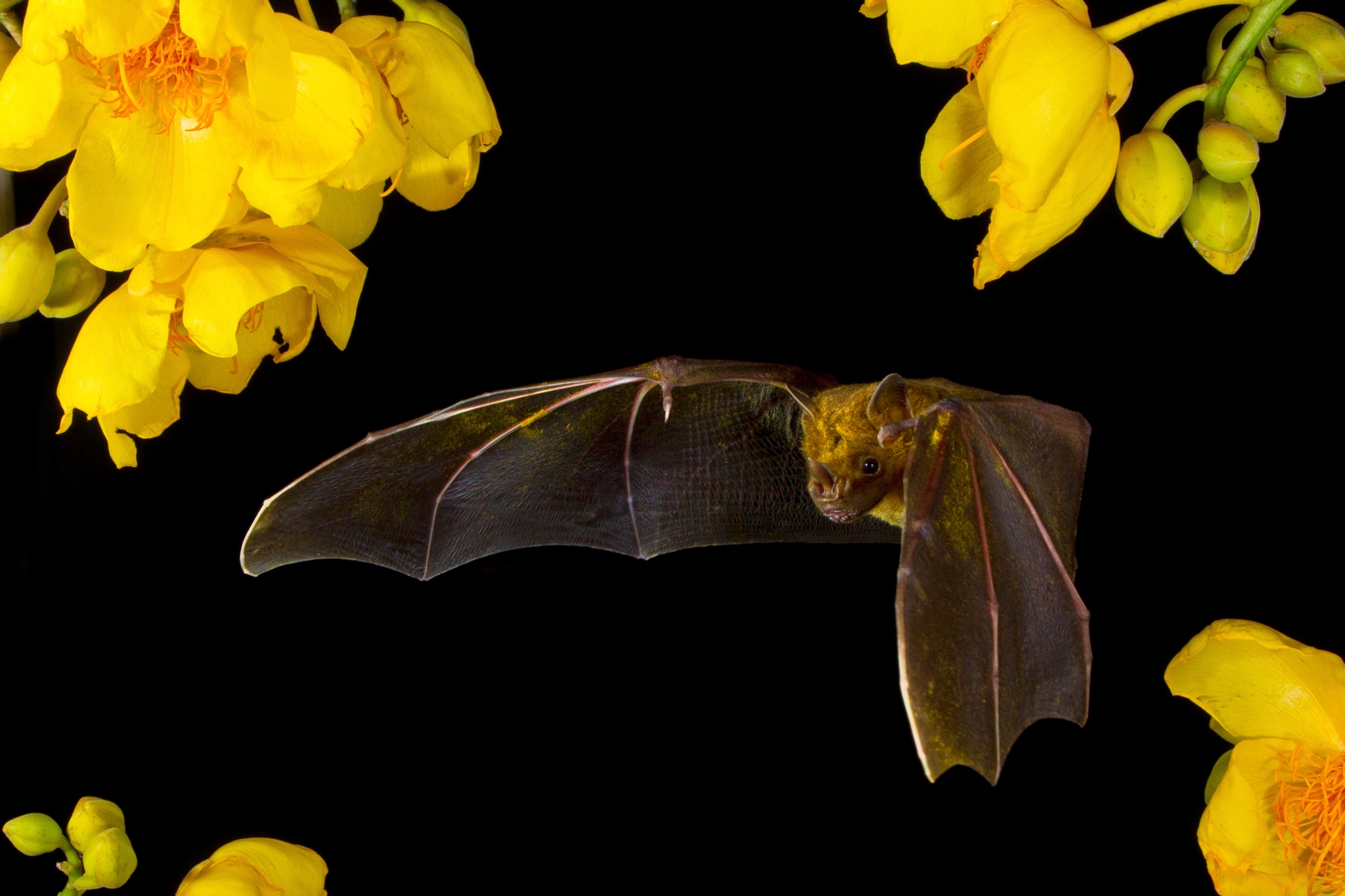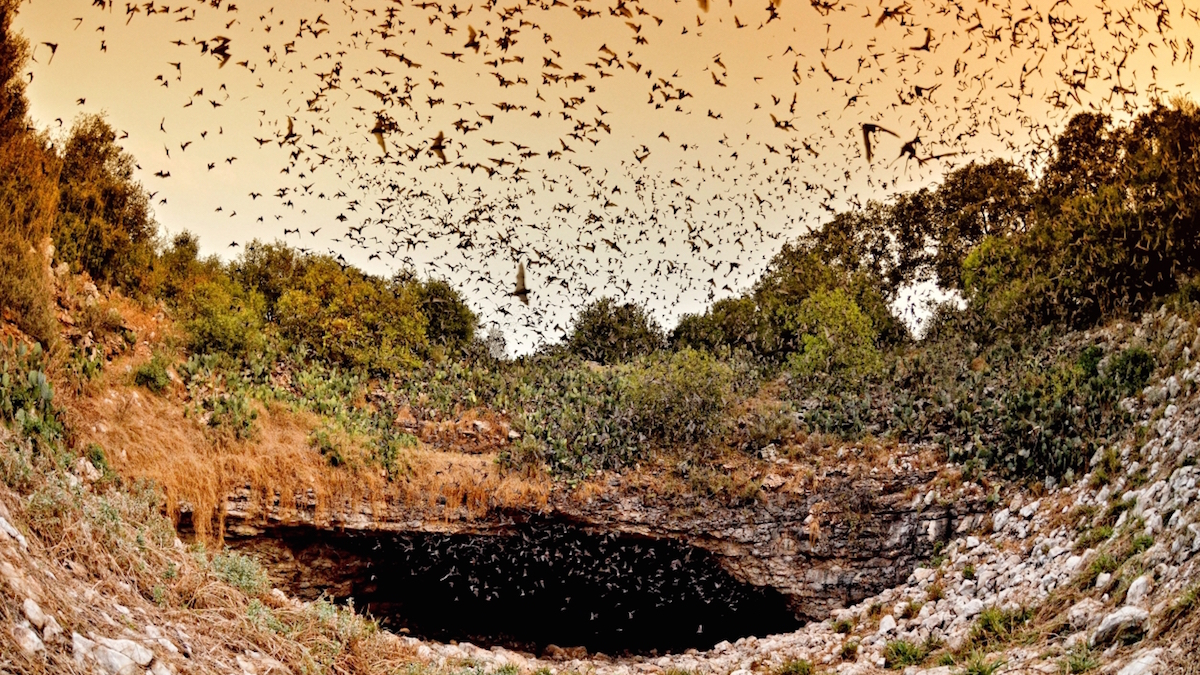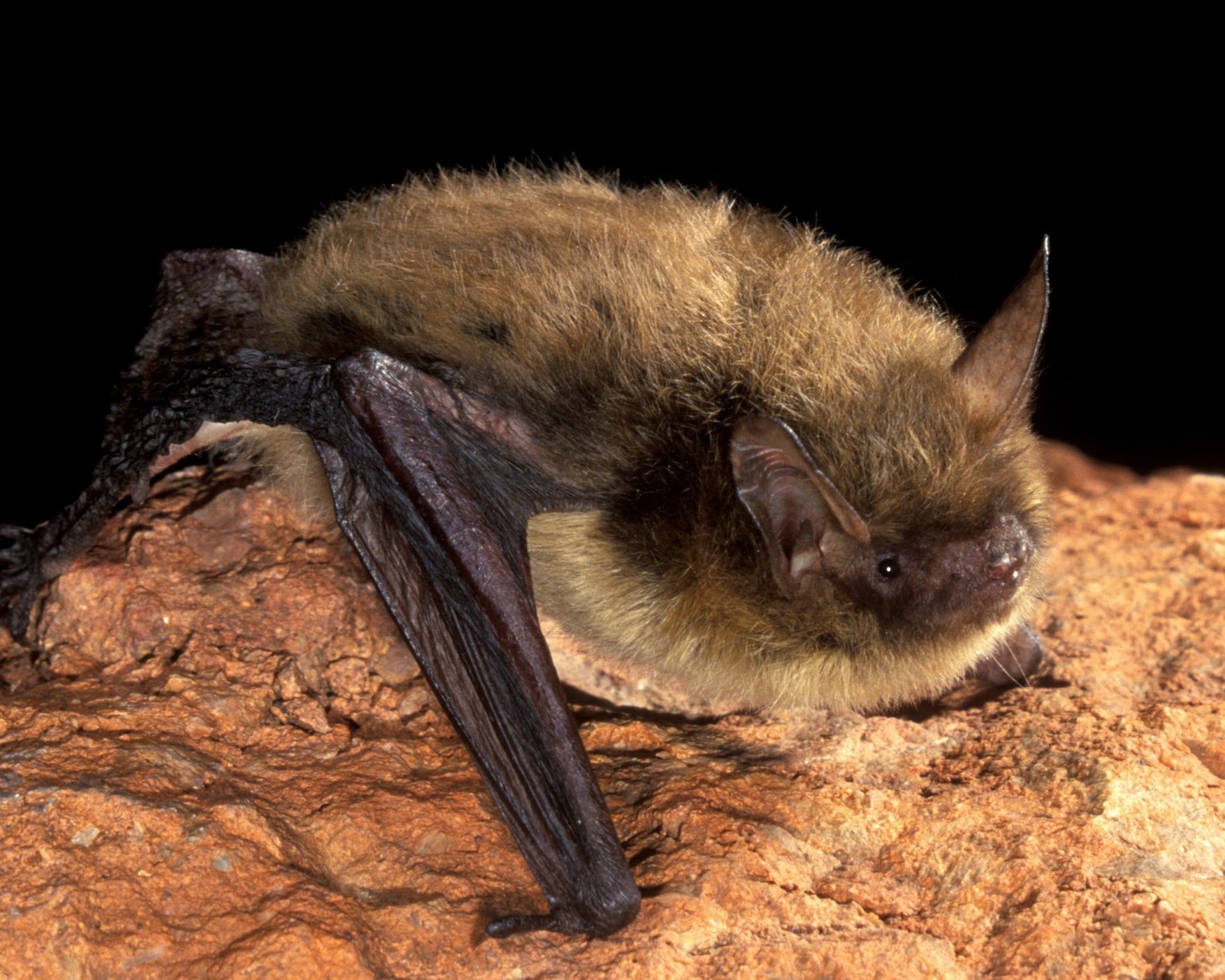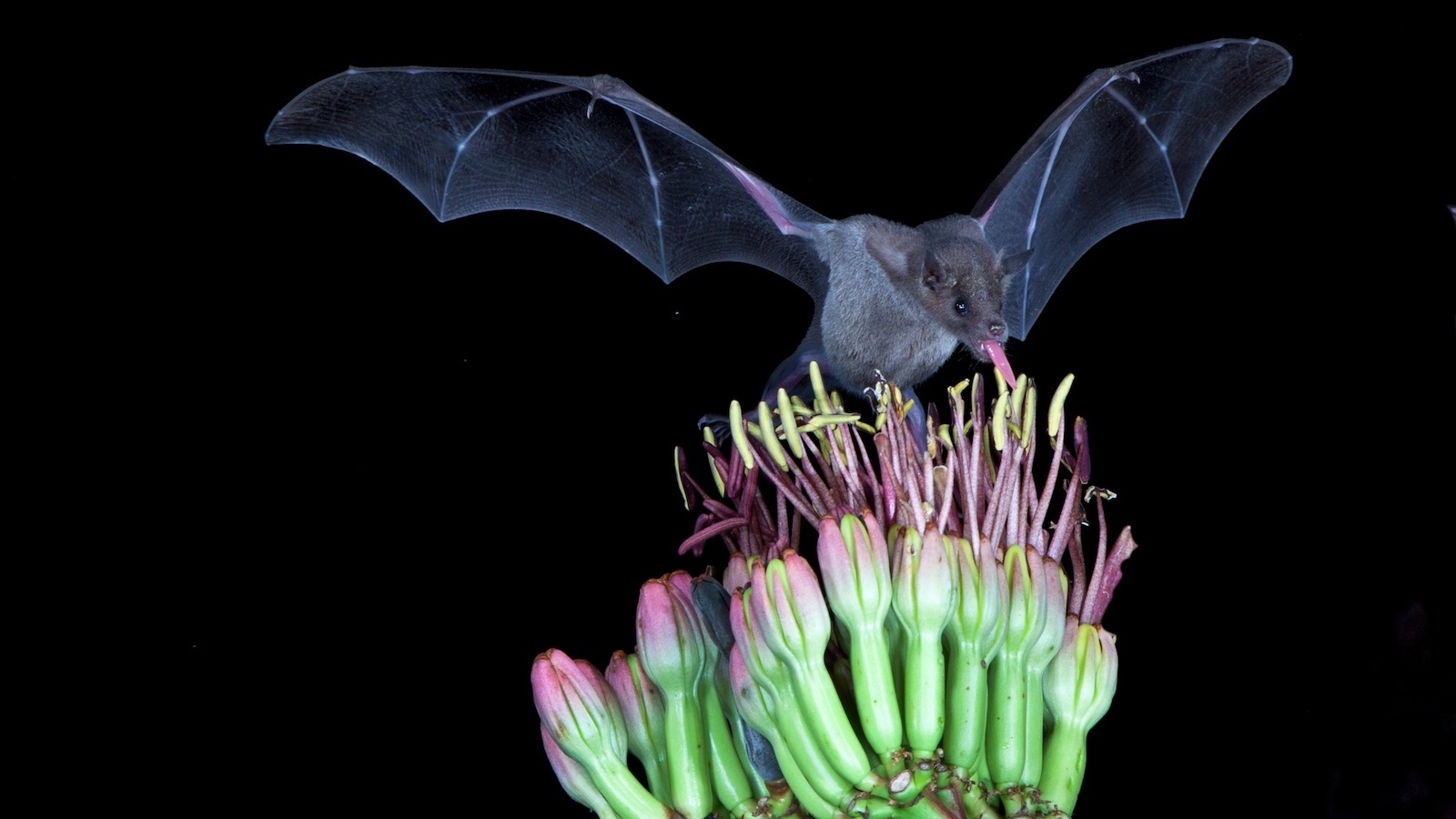The International Union for Conservation of Nature has identified more than 200 bat species worldwide that are critically endangered, endangered or vulnerable, and Bat Conservation International is composed of expert conservationists and scientists all working to stabilize the bat populations and help prevent their extinction.
For more than 50 million years, bats have existed on Earth and more than 1,400 species exist, according to BCI. Bats consume insects, pollinate plants, disperse seeds and are considered vital to the global ecosystem health. But their existence is threatened by habitat destruction, accelerated climate change, species that are invasive and other stressors.
In Austin, the Congress Avenue Bridge is the largest urban bat colony in North America and home to an estimated 1.5 million Mexican Free-Tailed bats, according to Global Animal. That colony of bats alone could eat approximately 10,000 to 30,000 pounds of insects in one night.

A Mexican free-tailed bat in flight. Photo by Bruce D. Taubert, courtesy of Bat Conservation International
Dr. Kristen Lear, of Bat Conservation International, in an interview with Kinute, explained BCI's founding, its mission, and how it works to save bats.
Q: How did Bat Conservation International come to be?
A: Based in Austin, Texas, our mission is to conserve the world’s bats and their ecosystems to ensure a healthy planet. We are dedicated to saving bat species and their habitats around the world. We were founded in 1982, and since then have grown into a globally recognized conservation organization dedicated to ending bat extinctions.
Working together, our goal is to redefine what is possible in global conservation, through the utilization of cutting-edge tools, technology, and training to create a real, measurable impact.
This year, Bat Conservation International celebrates its 40th anniversary. In our first few years, some of our work included helping to protect Asian wrinkle-lipped bats in Thailand and safeguarding the sustainable guano harvest important to the local monastery; protecting Judges Cave in Florida, which at the time served as Florida’s largest maternity roost for endangered Gray bats and is currently one of the top five maternity roosts for the Southeastern myotis; and protecting Gray bats in Hubbard’s Cave in Tennessee by installing a bat gate, which today is one of North America’s three most important bat hibernation sites.

After 40 years, BCI rediscovered the Hills' horseshoe bat, a Critically Endangered African bat species that hadn't been seen in four decades. Photo by Dr. Jon Flanders, courtesy of Bat Conservation International
In 1986, BCI moved our headquarters from Milwaukee, Wisconsin to Austin, Texas. The city was the epicenter of a major bat controversy when BCI relocated there. When the city’s Congress Avenue Bridge was rebuilt, a million or more Mexican Free-tailed Bats began roosting in the joints of the revamped bridge. There was a public outcry, with many bat myths taking hold, and BCI played a pivotal role in reversing these misconceptions about bats. Now Austin celebrates being the “Bat Capital of the World” where hundreds of people gather nightly during the summer to enjoy the bat emergence from Congress Avenue Bridge. The bats bring in over $10 million in tourism revenue to the city every year!
How do bats support global ecosystems and why are they so important?
Bats are critical to ecosystems and human economies around the world. Many of the over 1,400 species of bats around the world eat insects, and they provide a vital ecosystem service of pest consumption and control, helping protect crops such as corn, cotton, and pecans, just to name a few. Scientists estimate that insectivorous, or insect-eating, bats may save U.S. farmers roughly $23 billion each year by reducing crop damage and limiting the need for pesticides on their farms. For example, the millions of Mexican Free-tailed Bats at BCI’s Bracken Cave in Central Texas help target an especially damaging pest called the Corn Earworm Moth that attacks a variety of commercially-important plants from artichokes to watermelons.
Some bats around the world are nectarivorous (meaning they eat nectar from flowers). These bats pollinate hundreds of valuable cash crops, including bananas, guava, durians, cashews, dates, figs, cacao, sugar, corn, cotton, and agave (which we use to make tequila and mezcal!).

Pallid bats in the southwest are known to opportunistically feed on nectar. Photo by Dr. Winifred Frick, courtesy of Bat Conservation International
Fruit-eating bats in the tropics disperse seeds that are critical to restoring cleared or damaged rainforests. Night-foraging fruit bats often cover very large distances each night when they feed, and often fly across clearings and defecate in flight, scattering far more seeds than animals such as birds across cleared areas. Seeds dropped by bats can account for up to 95% of the first new growth in forests. The seeds dropped by bats are often from hardy pioneer plants, whose first growth serves as shelter and cover for more delicate plants.
And finally, bat poop (guano), is a valuable natural fertilizer with far-reaching benefits to landowners and communities.

Jamaican fruit bat is a fruit-eating bat native to Mexico, through Central America to northwestern South America. Photo by Bruce D. Taubert, courtesy of Bat Conservation International
Why are bats becoming endangered?
Loss of roosting and foraging habitats is one of the biggest threats to bat populations worldwide. Bats are also under threat from accelerated climate change, invasive species, wind energy, and white-nose syndrome.
Bats are bioindicators of ecosystem health, so when we see healthy bat populations, that’s an indication that the overall ecosystem is doing well. When we see bats in trouble, it often means the health of the overall ecosystem is also in trouble.
How has BCI helped bat populations to-date?
Our four current missions are: 1) implement endangered species interventions; 2) protect and restore landscapes; 3) conduct high-priority research and develop scalable solutions; and 4) inspire through experience. We work with diverse partners from government agencies, private landowners, industry, non-profit organizations, and academia to achieve success.
We have actionable plans to safeguard several highly endangered bat species around the world, including the Florida Bonneted Bat, the Jamaican Flower Bat and Jamaican Greater funnel-eared Bat, the Fijian Free-tailed Bat, Hill’s Horseshoe Bat, and Livingstone’s Flying Fox.

The grey-headed flying fox is the largest bat in Australia. Photo by Vivian Jones, courtesy of Bat Conservation International
Our habitat protection and restoration work focuses on restoring habitat in critical areas, protecting economically valuable colonies of bats, and abating threats at known roost sites. We work with federal, state, and private land managers to protect subterranean features such as abandoned mines for bats; we work on public lands in the U.S. to restore watersheds, riparian areas, and forests to support bats and healthy ecosystems; we manage Bracken Cave Preserve in central Texas (home to the world’s largest bat colony); and we work at a landscape scale across the U.S. Southwest and Mexico to restore healthy agave populations to support threatened pollinating bats and community livelihoods.

Bracken Cave Preserve in central Texas is home to the world’s largest bat colony. Photo by Jonathan Alonzo, courtesy of Bat Conservation International
We lead innovative research and global capacity building to develop scalable solutions to bat conservation challenges. We build global capacity by investing in the next generation of bat conservation leaders by supporting outstanding student scholars in bat conservation and research around the world. Since our Student Scholarship Program began in 1986, we have awarded over $1.2 million in scholarships for conservation-related bat studies in over 70 countries.
We are committed to bringing powerful bat experiences to the public to share the wonders of bats. At our Bracken Cave Preserve, we are committed to catalyzing the experience of Bracken bat flights to teach the public about the ecological and economic value of bats. Through our Bat Walks Program, we create unforgettable bat experiences for the public.
What is one thing most people don’t know about bats?
Bats are not rodents! Many bats are rodent-size (smaller than your hand), but unlike rodents, bats can live exceptionally long lives (over 40 years!), and most bat moms only have one pup, or baby, per year.
Some other fun facts: Bats have to flex to open their toes rather than close them and that’s how they hang from their feet without getting tired.
Some nectar-feeding bats have tongues longer than their bodies to reach deep into flowers for the nectar.
Bats really are quite amazing!

The Lesser long-nosed bat feeds on the nectar of agave plants and cacti. Photo by Bruce D. Taubert, courtesy of Bat Conservation International
Austin Bats tend to get a bad rap. What would you say to someone who is afraid of them?
I actually think the Austin bats are famous in a good way! The bats had a bad rap in the 1980s, but through BCI’s education and conservation work, the city has now embraced the bats, with tours, merchandise, and even an annual bat event.
In general, if someone is afraid of bats, I like to share about how they are animals just like any other (like the birds we see flying around our yards), and we can most certainly live together with them, as we’ve seen in Austin and other areas around the world.
What are some methods BCI uses to study bats/how is research conducted?
We embrace the adaptive management approach of the Open Standards for the Practice of Conservation. We prioritize our conservation efforts based on rigorous science and shared data. We’re an evidence-based organization and have many staff from a research background to design projects where we can effectively measure success.
Our efforts focus on improving our knowledge of bat populations, which helps inform conservation actions and investments in tools and partnerships. We conduct high-priority research to accelerate finding solutions to protect bats from the impacts of white-nose syndrome (WNS) and to reduce bat fatalities at wind energy facilities. In 2020, we established two new NABat monitoring hubs in the Pacific West and Southwest regions and launched the National Data Processing Laboratory to streamline acoustic data submissions for the NABat Monitoring Program. In Florida, we’re creating a robust network of citizen scientists to collect acoustic data to monitor the U.S.’s rarest bat, the Florida bonneted bat. We’re also developing cutting-edge conservation technology such as eDNA (environmental DNA) and drone-based methods to identify the migratory corridors of several nectarivorous bat species and help target our restoration work where it will be the most impactful.

The Northern long-eared bat was recently reclassified as endangered under the Endangered Species Act. Photo by J. Scott Altenbach, courtesy of Bat Conservation International
We build global capacity by investing in the next generation of bat conservation leaders by supporting outstanding student scholars in bat conservation and research around the world. We also develop multi-sectoral partnerships across industry, government, communities, private landowners, and academia to advance bat conservation. In our conservation efforts, we work closely with local communities and partners to ensure that our bat conservation work simultaneously supports local interests and needs, including through support of sustainable livelihoods, local economies, and cultural resources.
What does BCI’s five-year strategic plan involve?
Our Strategic Plan provides a clear and easily understandable framework for how we operate so that we can prevent species extinctions.
Can you tell us about the bat colony in Austin? What makes it so fascinating?
The Congress Avenue Bridge colony in Austin is the world’s largest urban bat colony, with over 1.5 million Mexican Free-tailed Bats calling the bridge home during the summer. It is a fascinating site because the bat viewing opportunities from above and next to the bridge provide an unparalleled opportunity to see the bats emerge for their nightly foraging. The colony is a maternity colony, where the female bats raise their babies, and they have become an integral part of Austin’s city identity.
BCI also owns Bracken Cave Preserve, home to the world’s largest bat colony, with an estimated 15-20 million Mexican Free-tailed Bats calling the cave home. We lead Bracken Bat Flight events during the summer to provide the public with an unforgettable experience witnessing the evening emergence of the world’s largest bat colony, and learning about the ecological and economic value of bats.
We have a wealth of information on our website, so check out batcon.org for more. And of course follow us on social media! We’re on Facebook, Instagram, and Twitter!
